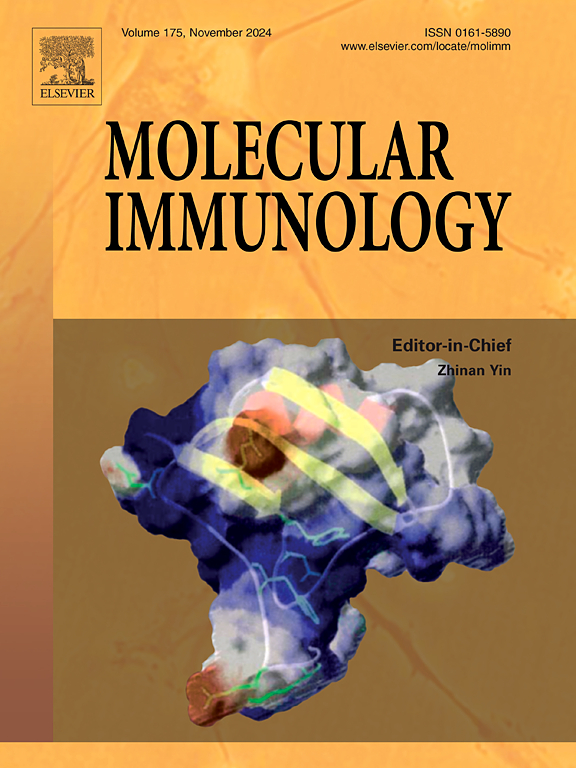姜黄素通过SCGB3A2抑制NF-κB通路调节哮喘气管上皮细胞自噬
IF 3
3区 医学
Q2 BIOCHEMISTRY & MOLECULAR BIOLOGY
引用次数: 0
摘要
背景与目的哮喘是一种慢性气道炎症性疾病,是一种严重的全球性健康负担。本研究旨在阐明姜黄素调节哮喘气管上皮细胞自噬的机制,特别关注其与SCGB3A2和NF-κB通路的相互作用。方法采用经TDI处理的16HBE细胞模拟体外哮喘模型。同时,建立了tdi诱导的Balb/c小鼠哮喘模型进行体内研究。通过姜黄素处理细胞或小鼠,敲低或过表达SCGB3A2,探讨SCGB3A2的功能。TNF-α和TPCA-1介导NF-κB的体外活化。采用Western blot、qPCR、ELISA、免疫荧光、透射电镜检测SCGB3A2表达、NF-κB通路激活、自噬、关键炎症因子、气道重塑指标。结果stdi刺激可降低16HBE细胞中SCGB3A2的表达。SCGB3A2过表达通过抑制NF-κB通路和增强自噬来减轻tdi诱导的炎症和气道重塑。随后NF-κB的激活部分消除了scgb3a2介导的炎症、气道重塑和自噬的保护作用。姜黄素处理上调SCGB3A2,抑制NF-κB活化,促进自噬;这些保护作用在SCGB3A2基因敲除后显著减弱。在体内实验中,姜黄素可以改善哮喘的特征,表现为气道炎症减轻、NF-κB抑制和气管上皮组织自噬增强。结论姜黄素通过调节SCGB3A2-NF-κ b自噬轴对哮喘有保护作用。这些发现突出了这个轴作为哮喘的一个新的治疗靶点。本文章由计算机程序翻译,如有差异,请以英文原文为准。
Curcumin modulates tracheal epithelial cell autophagy in asthma by inhibiting the NF-κB pathway via SCGB3A2
Background and objective
Asthma, a chronic inflammatory airway disease, presents a significant global health burden. This study aimed to elucidate the mechanism by which curcumin modulates tracheal epithelial cell autophagy in asthma, with a specific focus on its interplay with SCGB3A2 and the NF-κB pathway.
Methods
An in vitro asthma model was mimicked using 16HBE cells treated with TDI. Concurrently, a TDI-induced asthma model was built in Balb/c mice for in vivo investigations. Cells or mice were subjected to curcumin treatment, and SCGB3A2 was knockdown or overexpressed, to explore the function of SCGB3A2. TNF-α and TPCA-1 were also utilized to mediate activation of NF-κB in vitro. Western blot, qPCR, ELISA, immunofluorescence, and transmission electron microscopy were employed to assess SCGB3A2 expression, NF-κB pathway activation, autophagy, key inflammatory cytokines, and airway remodeling indicators.
Results
TDI stimulation reduced SCGB3A2 expression in 16HBE cells. SCGB3A2 overexpression mitigated TDI-induced inflammation and airway remodeling by inhibiting the NF-κB pathway and enhancing autophagy. Subsequent NF-κB activation partially abrogated these SCGB3A2-mediated protective effects on inflammation, airway remodeling, and autophagy. Curcumin treatment upregulated SCGB3A2, inhibited NF-κB activation, and promoted autophagy; these protective effects were substantially diminished upon SCGB3A2 knockdown. In vivo, curcumin administration ameliorated asthma features, evidenced by reduced airway inflammation, suppressed NF-κB, and enhanced autophagy in tracheal epithelial tissues.
Conclusions
This study reveals that curcumin protects against asthma by modulating the SCGB3A2-NF-κB-autophagy axis. These findings highlight this axis as a novel therapeutic target for asthma.
求助全文
通过发布文献求助,成功后即可免费获取论文全文。
去求助
来源期刊

Molecular immunology
医学-免疫学
CiteScore
6.90
自引率
2.80%
发文量
324
审稿时长
50 days
期刊介绍:
Molecular Immunology publishes original articles, reviews and commentaries on all areas of immunology, with a particular focus on description of cellular, biochemical or genetic mechanisms underlying immunological phenomena. Studies on all model organisms, from invertebrates to humans, are suitable. Examples include, but are not restricted to:
Infection, autoimmunity, transplantation, immunodeficiencies, inflammation and tumor immunology
Mechanisms of induction, regulation and termination of innate and adaptive immunity
Intercellular communication, cooperation and regulation
Intracellular mechanisms of immunity (endocytosis, protein trafficking, pathogen recognition, antigen presentation, etc)
Mechanisms of action of the cells and molecules of the immune system
Structural analysis
Development of the immune system
Comparative immunology and evolution of the immune system
"Omics" studies and bioinformatics
Vaccines, biotechnology and therapeutic manipulation of the immune system (therapeutic antibodies, cytokines, cellular therapies, etc)
Technical developments.
 求助内容:
求助内容: 应助结果提醒方式:
应助结果提醒方式:


